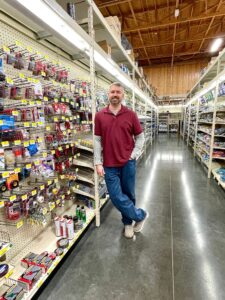Like a dull headache, retail shrink has always been an unfortunate reality of running a retail business. But for some retailers lately, that ache has grown into a splitting migraine.
Anecdotal evidence suggests shoplifters in some areas are growing bolder, sometimes violent, and local laws often make it harder to prosecute them. Cybercriminals threaten online data, posing yet another threat to businesses.
Regardless of what specific threats are impacting your operation, retail shrink is a drain on your profits and left unchecked, can grow to a larger problem.
Hardware Retailing interviewed loss prevention consultants and independent retailers for insights on the trends in retail loss and how to address them. While some of the tried and true methods of deterring criminals may still work, now is a good time to review the effectiveness of the tools in your loss prevention arsenal. By understanding your operation’s vulnerabilities, you can effectively create the best practices for facing these new threats.
Cybersecurity
Now, more than ever, retailers must contend with keeping their online data safe. Hacks, ransomware, e-commerce fraud and even customers who get their credit cards stolen can be costly to retailers. Nearly 60% of retailers responding to the National Retail Federation’s (NRF) 2023 Retail Security Survey said loss from e-commerce fraud was more of a concern than it was one year ago.
Employee Theft
According to numbers taken from the Annual Retail Theft Survey, compiled by Jack L. Hayes International, a loss prevention consulting company, recovery dollars from employee thefts increased in four of the last five years.
“Some of the issues contributing to the employee theft issues include more opportunities due to less management and staff and sales associate burnout resulting in them rationalizing their thefts,” says Mark Doyle, president of Jack L. Hayes International. “Dishonest employees also exploit promotional and reward programs, and when they see shoplifters getting away with theft, they think they can too.”
Shoplifting
Shoplifting now consistently eclipses employee theft as the No. 1 loss. NRF’s 2023 National Retail Security Survey reports that external theft accounts for 36% of a typical retailer’s loss, while internal shrink is 29%.
“In the home improvement industry, I’ve always spent most of my time helping retailers detect and prevent employee theft,” says Jim Close, managing partner at Risk Management Services Loss Prevention. “Rates of employee theft have always been higher than shoplifting. But for the first time in a long time, shoplifting has become a bigger concern.”
Shoplifting incidents and dollars lost to theft have increased over the past few years. According to the most recent Annual Retail Theft Survey from Jack L. Hayes International, the average shoplifting case value increased from $301.97 in 2018 to $802.01 in 2022.
Organized Retail Crime
While it’s not new, organized retail crime (ORC) is a concern for the independent sector. These professional criminals steal merchandise with the intent to sell it later. Independent home improvement retailers are prime targets for professional thieves because they have highly desirable and valuable items and are typically less likely to have comprehensive theft prevention systems.
The 2023 National Retail Security Survey from NRF listed batteries, mechanic tools, household chemicals, wire, plumbing, tools and kitchen accessories among the items most frequently targeted by ORC groups. Also in the same survey, 78% of retailers said ORC ranked higher in priority than one year ago.
Trends in Theft Deterrent
Some independent retailers may see an increase in shoplifting because they’re not keeping up with deterrent measures. If big-box retailers make it more difficult to steal by using technology such as electronic article surveillance (EAS) or radio frequency identification (RFID) chips in power tools that disable them until they’re purchased, and their independent counterparts are not, thieves will choose the easier target, Close says.
Retailers should evaluate what security measures their competition uses and consider if it’s feasible for their operations. It provides one less incentive for shoplifters looking for a place to steal.
“Thieves are looking for easy targets, and many of these are professionals rather than opportunists,” Close says. “From the anecdotal evidence I’ve seen, these thieves are coming into the store ahead of time, pre-shopping the store and coming back with the intent to steal. They’re also becoming a lot more brazen. They’ll grab and run, cutting security cables that might be on merchandise and run out the door.”
When shoplifters hit a store, rather than call 911, retailers tend to delay their reporting of the incident.
“I’m seeing a lot more post-incident documentation,” Close says. “Employees are more likely to document the incident first and then contact law enforcement later, a big change in the way retailers used to approach theft. In some areas, law enforcement won’t even respond to theft if it’s not over a certain dollar amount, so shoplifting incidents often go unreported. Retailers also have real concerns that local prosecutors won’t take their cases seriously.”
In response to higher shoplifting rates, camera systems and EAS remain the most cost-effective and preferable ways for retailers to protect their merchandise. Where those fail to deter criminals, retailers resort to placing more merchandise behind lock and key. Anecdotal evidence suggests that retailers are preferring locks and chains over expensive new technologies.
“I’ve seen retailers who would have never locked up their products are now encasing entire aisles in glass,” Close says. “It’s not just city retailers, either. It’s spreading to suburban operations.”
Other tactics include only displaying a sample product and keeping sellable inventory in the backroom, an approach that works well with power tools. Other retailers place high-theft items behind the counter so they’re highly visible but harder to steal.
While the lockdown approach is effective, retailers must make provisions for the ensuing customer service challenges. Locking items up can frustrate customers, especially if staff are slow to respond to a request for help. Close recommends that as many employees as possible have keys to access locked cases, and that there be enough staff on the floor to help everyone. If you’re going to lock up merchandise, follow through by walking the product up to the counter.
“That’s the part that sometimes gets left out,” Close says. “Skip that step and you could be just handing a shoplifter what they’re looking for.”
Overall, customer service remains one of the best tools independent retailers have to combat theft. More eyes on the salesfloor mean fewer opportunities for thieves to do their work. If you must lock up merchandise, outstanding service will help make the best out of a potentially frustrating situation for the customer.
Paper Shrink
The retail loss landscape isn’t only populated by criminal activity. The supply chain disruptions and staff shortages of 2020 brought with it other lingering issues.
In 2015, NRF’s National Retail Security Survey reported that retail losses from paper shrink made up 16.5% of all losses reported. The 2022 edition of the same NRF study reported that number jumped to 27%. What has traditionally been called paper shrink, or losses due to discrepancies between actual inventory and what’s recorded on the books, is typically due to reporting error and seems like it would be the most preventable of all losses.
Doyle says there are several factors impacting why paper shrink isn’t as preventable as it seems it should be.

“Prior to the pandemic, retailers were getting a pretty good handle on paper, or operational, shrink,” Doyle says. “Better systems and controls of operational losses were paying dividends, but on reopening after shutdowns in 2020 with less staff and more focus on external theft, paper losses have started to increase.”
The increase of customer services such as curbside pickup and buy online, pick up in store have also increased retailers’ vulnerability.
“With each new way of moving, picking and delivering merchandise, there comes a new set of opportunities for paper and operational loss,” Doyle says. “Retailers have to establish and maintain control points in each new procedure to reduce their vulnerability to loss. Limiting multiple tasks where the same associate picks, prepares and delivers merchandise and requiring second-person verification are key components to reducing theft and paper shrink.”
Effect on Consumers
Theft doesn’t just affect profits. Increased crime negatively affects customers and a retailer’s brand perception. According to a survey by Coresight Research, 73% of consumers were concerned that retailers would raise prices to cover the cost of theft, and 25% said they would do more shopping online if their local stores began using theft prevention methods such as locking up merchandise.
Some shoppers may even be afraid to shop at stores that have frequent shoplifting incidents, particularly when they become violent. All of these factors can devalue a retailer’s brand if they don’t take steps to control them.
Legislators’ Response
Retailers have appealed to local and national legislators to respond to the increase in crime. In 2022, Congress passed the bipartisan INFORM Consumers Act, which requires online marketplaces to verify the identity of high volume, third-party merchants. This increase in transparency will make it more difficult to sell stolen goods online.
The NRF is currently advocating for passage of the Combating Organized Retail Crime Act (CORCA), which will increase the coordination between federal, state and local law enforcement to fight retail crime.
Discouraging Shoplifters at Whitmore Ace Hardware
Over the past five years, David Cripe, the owner of Whitmore Ace Hardware with 14 locations in northeastern Illinois, has noticed a spike in the number of shoplifting incidents in his operation.
“Shoplifting used to be smaller thefts. We’d find an opened package in a corner of the store, it wasn’t blatant,” he says. “Now, thieves will come into the store, grab an armload of products from the shelf and run out the front door, sometimes smiling at the cashier as they go.”
Rather than locking down all the merchandise, Cripe has found more subtle ways to make the store more of a deterrent for thieves. As part of a recent remodel to one location, he moved the high-theft items away from the front door and closer to the service desk in the middle of the floor. He placed cameras closer to eye level in areas such as the outdoor power equipment aisle so he can get a better view of people’s faces in that area. He also repositioned some of the outdoor cameras to take pictures of license plates of cars leaving the lot.
Cripe has also responded to the increase in crime by putting more emphasis on training and customer service so employees are better equipped to prevent an incident but also know how to respond when one happens.
Some of the art of effective customer service lies in knowing how to engage a customer when you suspect they may be stealing from you. Cripe advises his employees that if they see someone they think is shoplifting to approach them and ask questions that will make it appear like they are just helping the customer make the right purchase. If they’re trying to steal, they’ll be very uncomfortable.
Cripe hired a loss prevention consultant to train his staff on how to respond to an active shoplifter and has invested in technology that makes it easier for him to gather the necessary information to report an incident to the police.
Communication is critical when dealing with a shoplifter. With 13 locations in a tight geographical area, Cripe says once one store gets hit with a shoplifting incident, other locations can expect it too. Staff share information as soon as a theft happens so employees at other locations can be on the alert.
“We want all associates to know it is a very big deal when someone steals from us,” he says. “We don’t want them to be complacent and think this is business as usual. We broadcast every theft to all key employees across all locations. This lets them know we are monitoring what happens here and will take every theft seriously.”
5 Best Practices to Address Shoplifting
- Place high-theft items in highly visible areas where staff can easily monitor them.
- Greet each customer as they enter the store.
- Always be mindful of where customers are in the store and continually engage with them.
- Make sure employees understand company policy for what to do during a shoplifting incident.
- Have a camera system covering the salesfloor and parking lot so you can document shoplifting incidents.
Managing Delinquent Payments at West Side Decorating Center
Some of the retail shrink you write off at the end of the year may be easier to fix than stopping shoplifters. Discrepancies in inventory reporting and issues in accounts receivable can often be fixed by implementing tighter controls.
At West Side Decorating Center in Saginaw, Michigan, manager Maverick Spoke says the operation minimizes inventory reporting issues by having its employees double-check their work or having redundancies in place.
“A lot of the inventory discrepancies we had were when one person was receiving a shipment,” he says. “So we started having two people do it—one to check the order quantity and the other to mark it off on the PO.”
However, one of the biggest sources of loss in recent years has come from the accounts receivable department. Installed sales of flooring, window treatments and countertops are a major part of the business, and they’ve recently had a more difficult time collecting payment from customers.
“Before the pandemic, most of our shrink was due to inventory errors; we didn’t have a big problem with shoplifting,” Spoke says. “But in the past couple of years, as people are unsure about the economy, more people are having buyer’s remorse and not paying their bills.”
An unpaid bill—another form of theft—can leave the West Side team spending more time with calls to the customer asking for payment. They’ll hire a collection agency for larger bills, but even then, collectors aren’t always able to recover the funds, leaving the company to write off the loss.
Up to this point, the staff has only collected a deposit of half the invoice for custom installations, with the balance due upon completion of the job. That system is changing. Store policy now requires payment in full several days before the installation can begin.
“We’ve had a little pushback from some of our customers, but most people understand that this is how most retailers operate these days,” Spoke says. “We are working with a lawyer to come up with contracts specific to the different products we sell. It’s important to clearly communicate payment terms upfront so customers know what to expect.”
5 Best Practices To Avoid Paper Shrink
- Double check quantity and SKUs on packing slips against purchase orders.
- Have two people involved in the receiving process.
- Shoot the outs, or scan for out of stock inventory, weekly.
- Do regular inventory cycle counts, not just once a year.
- Never process a return, defective or adjustment without first recording it through the POS.
Dealing With Internal Theft at Damariscotta Hardware
Perhaps the most difficult type of theft to deal with is when it comes from your own employees. It’s a betrayal, potentially by someone high in the ranks of leadership. When it does happen, it’s important not to overreact and destroy any culture of trust you have already built with the rest of your staff.
In 2018, Rob Gardiner, owner of Damariscotta Hardware in Damariscotta, Maine, discovered that a manager had stolen several thousand dollars of merchandise from the business. And that was despite rigorous accountability measures Gardiner already had in place.
“We were doing everything we could do to create accountability, but at some point, you just have to trust your staff,” he says. “We didn’t change much after the incident because we didn’t want to penalize the next person in that position. I don’t think the staff felt we started clamping down harder just because one bad thing happened.”
For Gardiner, it was an isolated incident that hasn’t happened again. Accountability and leading by example are both key in preventing theft, whether it’s internal or external.
“The best thing to do is trust but verify,” he says. “Make sure employees know store loss prevention policies and procedures and follow up by holding everyone accountable to those standards.”
For example, if you emphasize the importance of customer service in deterring shoplifting, then lead by example and spend some time on the salefloor with customers.
“Staff will usually replicate what they see you doing. When employees see you care, they’re going to care too and will be mindful of those red flags that signal something could be wrong,” he says. “Remind everyone that if they see something suspicious, say something.”
5 Best Practices to Deter Employee Theft
- Use exception-based monitoring to catch theft at the point of sale.
- Limit who can take out the trash and use clear trash bags.
- Build a positive company culture so all employees feel they are a valued part of the team.
- Rotate cashiers and change their cash drawer assignments regularly to deter collusion.
- Conduct unannounced cash drawer audits.
Battling Cybercrime and Other Scams at Island Lumber
Even though it is on an island in the Pacific Northwest, Island Home Center and Lumber in Vashon, Washington, isn’t isolated from the threat of crime. Shrinkage and theft issues still threaten the business, and like many single store operations, there’s no dedicated loss prevention team. However it does have an advantage when it comes to securing the store’s online integrity. Manager Rob Hord draws on his background in IT and cybersecurity to create robust protective measures for the store to reduce the likelihood of suffering a cyberattack.
 One of the keys to effective cyber protection is having the proper policies in place to govern employee’s use of company email and data systems. He uses the “least privilege” security model, a common security practice that gives employees the lowest level of access to computer systems they need to do their job. This includes managers and owners, who may not need continual access to admin rights.
One of the keys to effective cyber protection is having the proper policies in place to govern employee’s use of company email and data systems. He uses the “least privilege” security model, a common security practice that gives employees the lowest level of access to computer systems they need to do their job. This includes managers and owners, who may not need continual access to admin rights.
“Users can run basic point-of-sale applications and browse the web, but they cannot make changes to the system or install applications,” Hord says. “This protects our staff from accidentally installing malware. The key is restricting the business owner and IT team to also using regular accounts in their daily routines. It’s unfortunately very common that many business owners insist on having full administrator privileges on the network, and as a result, the owner is often the culprit who clicked on something they should not have.”
Another safeguard is a data backup plan. Hord recommends a cloud-based daily backup system with version history and a system like Office 365 where employees can back up documents to the cloud.

“Migrating to the cloud offloads the hardware risk from our local business and significantly reduces our responsibility to the threat surface area,” Hord says. “Version history is critical because if our backups also get infected, which can happen if a backup happens before we catch the infection, then we can retrieve a prior ‘clean’ backup.”
If your store’s computers get hacked, it’s important to have an insurance policy that will give you complete coverage and some peace of mind.
“If an event happened to us tomorrow, we’d call the insurance company and put it in their hands, move to handwritten receipts for our daily transactions and trust that our inventory levels could carry us through the remediation process until we’re back online,” Hord says. Click here for more of Hord’s suggestions on preventing a cyberattack.
5 Best Practices To Defeat Cybercriminals
- Train employees to detect phishing, vishing and other scams.
- Keep all software updated.
- Use a password manager.
- Have a cyber rider on your insurance policy.
- Store data on the cloud.
 Hardware Retailing The Industry's Source for Insights and Information
Hardware Retailing The Industry's Source for Insights and Information








